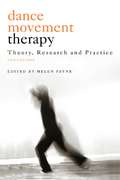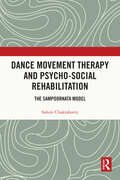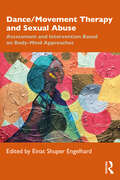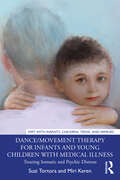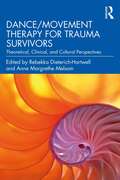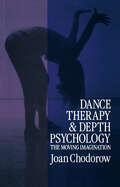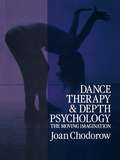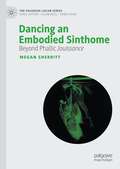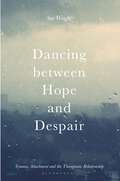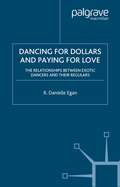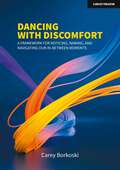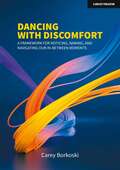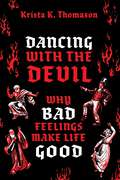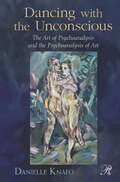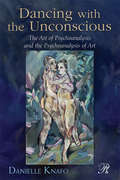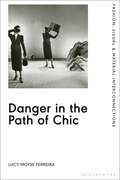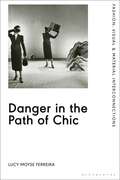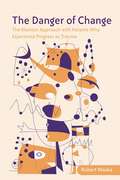- Table View
- List View
Dance Movement Therapy: Theory, Research and Practice
by Helen PayneWhat can dance movement contribute to psychotherapy? This thoroughly updated edition of Dance Movement Therapy echoes the increased world-wide interest in dance movement therapy and makes a strong contribution to the emerging awareness of the nature of embodiment in psychotherapy. Recent research is incorporated, along with developments in theory and practice, to provide a comprehensive overview of this fast-growing field. Helen Payne brings together contributions from experts in the field to offer the reader a valuable insight into the theory and practice of Dance Movement Therapy. The contributions reflect the breadth of developing approaches, covering subjects including: dance movement therapy with people with dementia group work with people with enduring mental health difficulties transcultural competence in dance movement therapy freudian thought applied to authentic movement embodiment in dance movement therapy training and practice personal development through dance movement therapy. Dance Movement Therapy will be a valuable resource for anyone who wishes to learn more about the therapeutic use of creative movement and dance. It will be welcomed by students and practitioners in the arts therapies, psychotherapy, counselling and other health and social care professions.
Dance Movement Therapy: Theory, Research and Practice
by Helen PayneWhat can dance movement contribute to psychotherapy? This thoroughly updated edition of Dance Movement Therapy echoes the increased world-wide interest in dance movement therapy and makes a strong contribution to the emerging awareness of the nature of embodiment in psychotherapy. Recent research is incorporated, along with developments in theory and practice, to provide a comprehensive overview of this fast-growing field. Helen Payne brings together contributions from experts in the field to offer the reader a valuable insight into the theory and practice of Dance Movement Therapy. The contributions reflect the breadth of developing approaches, covering subjects including: dance movement therapy with people with dementia group work with people with enduring mental health difficulties transcultural competence in dance movement therapy freudian thought applied to authentic movement embodiment in dance movement therapy training and practice personal development through dance movement therapy. Dance Movement Therapy will be a valuable resource for anyone who wishes to learn more about the therapeutic use of creative movement and dance. It will be welcomed by students and practitioners in the arts therapies, psychotherapy, counselling and other health and social care professions.
Dance Movement Therapy and Psycho-social Rehabilitation: The Sampoornata Model
by Sohini ChakrabortyThis book looks at the psychotherapeutic effects of Dance Movement Therapy (DMT) with a focus on the experiences of survivors of gender-based violence and their social development, psycho-social rehabilitation, and reintegration within society. The author, a sociologist and dancer, uses a model she calls Sampoornata— or Fulfilment, to merge sociology and dance in order to help survivors of sexual violence overcome their trauma. Sampoornata was developed to help survivors of gender-based violence and trafficking, by focusing on their specific needs, and helping them to express themselves and overcome emotional and psychological pain. Through interviews with and detailed narratives of survivors, the book takes the readers through the development of the model, its implementation, practice, and impact on their lives. Situated within the social, cultural, as well as geographical context of India, the book is an important resource for rethinking the creative approaches, theories, and practice of DMT worldwide. This book will be of interest to researchers and students of psychology, psychotherapy, dance and movement studies, and to those who work with dance and movement therapy. It will also be useful for professionals working in the areas of gender violence, trafficking, trauma, psycho-social rehabilitation, and well-being.
Dance Movement Therapy and Psycho-social Rehabilitation: The Sampoornata Model
by Sohini ChakrabortyThis book looks at the psychotherapeutic effects of Dance Movement Therapy (DMT) with a focus on the experiences of survivors of gender-based violence and their social development, psycho-social rehabilitation, and reintegration within society. The author, a sociologist and dancer, uses a model she calls Sampoornata— or Fulfilment, to merge sociology and dance in order to help survivors of sexual violence overcome their trauma. Sampoornata was developed to help survivors of gender-based violence and trafficking, by focusing on their specific needs, and helping them to express themselves and overcome emotional and psychological pain. Through interviews with and detailed narratives of survivors, the book takes the readers through the development of the model, its implementation, practice, and impact on their lives. Situated within the social, cultural, as well as geographical context of India, the book is an important resource for rethinking the creative approaches, theories, and practice of DMT worldwide. This book will be of interest to researchers and students of psychology, psychotherapy, dance and movement studies, and to those who work with dance and movement therapy. It will also be useful for professionals working in the areas of gender violence, trafficking, trauma, psycho-social rehabilitation, and well-being.
Dance/Movement Therapy and Sexual Abuse: Assessment and Intervention Based on Body-Mind Approaches
by Einat Shuper EngelhardDance/Movement Therapy and Sexual Abuse addresses the vital role dance/movement therapy plays in helping survivors of sexual abuse. Comprising ten chapters, the book describes assessment, diagnosis and intervention techniques with child, adolescent, and adult survivors of sexual abuse. Using case studies, contributing experts in the field offer the reader a profound understanding of the therapeutic techniques related to movement and the body for the emotional treatment of situations of sexual abuse. The chapters delve into the healing components of treatment during childhood, adolescence, and adulthood, and combine psychodynamic understandings with body-mind theories, techniques from the area of somatic experience, and bio-energetic analysis. Full of in-depth and comprehensive therapeutic interventions using dance/movement therapy to treat sexual trauma, this book will be an essential resource for dance/movement therapists and students of the creative arts therapies.
Dance/Movement Therapy and Sexual Abuse: Assessment and Intervention Based on Body-Mind Approaches
by Einat Shuper EngelhardDance/Movement Therapy and Sexual Abuse addresses the vital role dance/movement therapy plays in helping survivors of sexual abuse. Comprising ten chapters, the book describes assessment, diagnosis and intervention techniques with child, adolescent, and adult survivors of sexual abuse. Using case studies, contributing experts in the field offer the reader a profound understanding of the therapeutic techniques related to movement and the body for the emotional treatment of situations of sexual abuse. The chapters delve into the healing components of treatment during childhood, adolescence, and adulthood, and combine psychodynamic understandings with body-mind theories, techniques from the area of somatic experience, and bio-energetic analysis. Full of in-depth and comprehensive therapeutic interventions using dance/movement therapy to treat sexual trauma, this book will be an essential resource for dance/movement therapists and students of the creative arts therapies.
Dance/Movement Therapy for Infants and Young Children with Medical Illness: Treating Somatic and Psychic Distress (DMT with Infants, Children, Teens, and Families)
by Suzi Tortora Miri KerenThis book presents dance/movement therapy as a window into the emotional and internal experience of a baby with a medical illness, within the context of treating the whole family system and using the DC 0-5 as the basis for formulating the clinical situation. This book fills a gap in the literature, bringing a variety of fields together including infant mental health, infant and child psychiatry, nonverbal-movement analysis, and the creative arts therapies. Grounded in a biopsychosocial perspective, dance/movement therapy is introduced as the main treatment modality, using nonverbal expression as a means of communication, and dance and music activities as intervention tools, to support the child and family. Vignettes from both during and years after the medical experience are presented throughout the book, taking into consideration the subtle and more obvious effects of illness on the child’s later emotional, social, and behavioral development. They illustrate the expertise of the authors as infant mental health professionals, drawing upon their work in hospitals and private practices, and highlight their unique perspectives and years of collaboration. This exciting new book is essential reading for clinicians and mental health professionals working with infants and their families.
Dance/Movement Therapy for Infants and Young Children with Medical Illness: Treating Somatic and Psychic Distress (DMT with Infants, Children, Teens, and Families)
by Suzi Tortora Miri KerenThis book presents dance/movement therapy as a window into the emotional and internal experience of a baby with a medical illness, within the context of treating the whole family system and using the DC 0-5 as the basis for formulating the clinical situation. This book fills a gap in the literature, bringing a variety of fields together including infant mental health, infant and child psychiatry, nonverbal-movement analysis, and the creative arts therapies. Grounded in a biopsychosocial perspective, dance/movement therapy is introduced as the main treatment modality, using nonverbal expression as a means of communication, and dance and music activities as intervention tools, to support the child and family. Vignettes from both during and years after the medical experience are presented throughout the book, taking into consideration the subtle and more obvious effects of illness on the child’s later emotional, social, and behavioral development. They illustrate the expertise of the authors as infant mental health professionals, drawing upon their work in hospitals and private practices, and highlight their unique perspectives and years of collaboration. This exciting new book is essential reading for clinicians and mental health professionals working with infants and their families.
Dance/Movement Therapy for Trauma Survivors: Theoretical, Clinical, and Cultural Perspectives
by Rebekka Dieterich-HartwellThis book offers a timely, detailed, and comprehensive synopsis of dance/movement therapy (DMT) in the treatment of psychological trauma. Along with the foundational concepts of DMT, tied to traditional trauma theory and a neurobiological framework, contributions contain rich clinical examples that illustrate the use of dance, creative movement, and body awareness with a wide variety of populations including survivors of sex trafficking, military veterans, refugees, those with multigenerational trauma, and others. Chapters emphasize the underlying influences of power, privilege, and oppression on trauma, prompting practitioners to consider and understand the dynamics of sociocultural contexts and engage in continuous self-reflection. Featuring multiple perspectives, as well as cultural and contextual considerations, this book provides direct takeaways for clinicians and professionals and concludes with a roadmap for the trajectory of trauma-informed, healing-centered DMT.
Dance/Movement Therapy for Trauma Survivors: Theoretical, Clinical, and Cultural Perspectives
by Rebekka Dieterich-Hartwell Anne Margrethe MelsomThis book offers a timely, detailed, and comprehensive synopsis of dance/movement therapy (DMT) in the treatment of psychological trauma. Along with the foundational concepts of DMT, tied to traditional trauma theory and a neurobiological framework, contributions contain rich clinical examples that illustrate the use of dance, creative movement, and body awareness with a wide variety of populations including survivors of sex trafficking, military veterans, refugees, those with multigenerational trauma, and others. Chapters emphasize the underlying influences of power, privilege, and oppression on trauma, prompting practitioners to consider and understand the dynamics of sociocultural contexts and engage in continuous self-reflection. Featuring multiple perspectives, as well as cultural and contextual considerations, this book provides direct takeaways for clinicians and professionals and concludes with a roadmap for the trajectory of trauma-informed, healing-centered DMT.
Dance Therapy and Depth Psychology: The Moving Imagination
by Joan ChodorowDance/movement as active imagination was originated by Jung in 1916. Developed in the 1960s by dance therapy pioneer Mary Whitehouse, it is today both an approach to dance therapy as well as a form of active imagination in analysis. In her delightful book Joan Chodorow provides an introduction to the origins, theory and practice of dance/movement as active imagination.Beginning with her own story the author shows how dance/ movement is of value to psychotherapy. An historical overview of Jung's basic concepts is given as well as the most recent depth psychological synthesis of affect theory based on the work of Sylvan Tomkins, Louis Stewart, and others. Finally in discussing the use of dance/movement as active imagination in practice, the movement themes that emerge and the non-verbal expressive aspects of the therapaeutic relationship are described.
Dance Therapy and Depth Psychology: The Moving Imagination
by Joan ChodorowDance/movement as active imagination was originated by Jung in 1916. Developed in the 1960s by dance therapy pioneer Mary Whitehouse, it is today both an approach to dance therapy as well as a form of active imagination in analysis. In her delightful book Joan Chodorow provides an introduction to the origins, theory and practice of dance/movement as active imagination.Beginning with her own story the author shows how dance/ movement is of value to psychotherapy. An historical overview of Jung's basic concepts is given as well as the most recent depth psychological synthesis of affect theory based on the work of Sylvan Tomkins, Louis Stewart, and others. Finally in discussing the use of dance/movement as active imagination in practice, the movement themes that emerge and the non-verbal expressive aspects of the therapaeutic relationship are described.
Dancing an Embodied Sinthome: Beyond Phallic Jouissance (The Palgrave Lacan Series)
by Megan SherrittThis book provides the first in-depth analysis of Lacanian psychoanalytic theory and the art of dance and explores what each practice can offer the other. It takes as its starting point Jacques Lacan’s assertion that James Joyce’s literary works helped him create what Lacan terms a sinthome, thereby preventing psychosis. That is, Joyce’s use of written language helped him maintain a “normal” existence despite showing tendencies towards psychosis. Here it is proposed that writing was only the method through which Joyce worked but that the key element in his sinthome was play, specifically the play of the Lacanian real.The book moves on to consider how dance operates similarly to Joyce’s writing and details the components of Joyce’s sinthome, not as a product that keeps him sane, but as an interminable process for coping with the (Lacanian) real. The author contends that Joyce goes beyond words and meaning, using language’s metre, tone, rhythm, and cadence to play with the real, mirroring his experience of it and confining it to his works, creating order in the chaos of his mind. The art of dance is shown to be a process that likewise allows one to play with the real. However, it is emphasized that dance goes further: it also teaches someone how to play if one doesn't already know how. This book offers a compelling analysis that sheds new light on the fields of psychoanalysis and dance and looks to what this can tell us about—and the possibilities for—both practices, concluding that psychoanalysis and dance both offer processes that open possibilities that might otherwise seem impossible. This original analysis will be of particular interest to those working in the fields of psychoanalysis, aesthetics, psychoanalytic theory, critical theory, art therapy, and dance studies.
Dancing between Hope and Despair: Trauma, Attachment and the Therapeutic Relationship
by Sue WrightWhy is hope so fundamental to our existence?In considering this and many other questions, this evocative book introduces the reader to the repeated shifting, or 'dance', between hope and despair that is so often encountered by practitioners working with profoundly traumatised individuals. Drawing on a broad range of theoretical perspectives and illustrated by a wealth of case studies and first-hand experiences, the book brings a sharp focus to the ways in which therapeutic relationships can draw individuals out of the constant oscillation between light and dark. It provides an insightful and thoughtful discussion not just about despair itself, but about how to be with despair: about how practitioners can help clients turn towards the experiences of emotional pain, and stand with them in the face of it. Topics covered include: • The concept of hope, and the differences between realistic and illusory hope• How trauma and attachment failure at different life stages can contribute to the loss of hope• The benefits of taking a highly relational approach to hopelessness, with an emphasis on integrating mind, body and emotions. Informed by the author's own years of experience in the field of psychotherapy, this engaging and stimulating book provides practical guidance on how students, trainees and practitioners can inspire fresh hope in deeply troubled clients.
Dancing for Dollars and Paying for Love: The Relationships between Exotic Dancers and their Regulars
by D. EganThis book takes an in-depth look at the relationships exotic dancers have with their regular customers, and explores the limits of using feminist theory to discuss sex work. This is an accessible, revealing, and new look at a perennially intriguing and divisive subject - ideal teaching material for undergraduate courses in a variety of fields.
Dancing with Discomfort: A framework for noticing, naming, and navigating our in-between moments
by Carey BorkoskiTransitions are universal. They include the important and familiar milestones of starting kindergarten, graduating from high school or college, and becoming employed, parents, or retirees. These transitional moments, however, also include unexpected or unanticipated events like losing a job, joining a running club, or experiencing a global pandemic. In each of these moments, individuals, groups, and organizations experience the anxiety, self-doubt, worry, and uncertainty associated with these novel experiences. Our natural response to these moments is to avoid, side-step, or hurry through until this moment of transition is over. The problem with these strategies is that while we are trying to shut out the unpleasant feelings of those moments, we also miss all the possibilities and discovery. What if we invested time, training, and space to learn, experiment with and strengthen our ability to wrestle with and successfully navigate these moments of transition? Whether a significant transition like moving into a new school or just shifting from one project to the next, we need to build strategies and techniques to leverage and learn from the discomfort that individuals experience during these moments. This book offers names and faces for our feelings, thoughts, and reactions in our transitions. It is based on sound research and data collected by the author and other researchers but is also based on the author’s experiences, mistakes, reflection, and learning from doing the work in different contexts. It includes a framework to learn to stay in these transitions, embrace dissonance, and leverage these moments of discovery. Whether you want to introduce this transitions framework and strategies in a classroom, boardroom, or your own life, this book is for you and your organization to start the intentional work to create spaces, and time to name, feel, explore, reflect on, and move through the myriad transitions occurring during our personal and professional journeys.
Dancing with Discomfort: A framework for noticing, naming, and navigating our in-between moments
by Carey BorkoskiTransitions are universal. They include the important and familiar milestones of starting kindergarten, graduating from high school or college, and becoming employed, parents, or retirees. These transitional moments, however, also include unexpected or unanticipated events like losing a job, joining a running club, or experiencing a global pandemic. In each of these moments, individuals, groups, and organizations experience the anxiety, self-doubt, worry, and uncertainty associated with these novel experiences. Our natural response to these moments is to avoid, side-step, or hurry through until this moment of transition is over. The problem with these strategies is that while we are trying to shut out the unpleasant feelings of those moments, we also miss all the possibilities and discovery. What if we invested time, training, and space to learn, experiment with and strengthen our ability to wrestle with and successfully navigate these moments of transition? Whether a significant transition like moving into a new school or just shifting from one project to the next, we need to build strategies and techniques to leverage and learn from the discomfort that individuals experience during these moments. This book offers names and faces for our feelings, thoughts, and reactions in our transitions. It is based on sound research and data collected by the author and other researchers but is also based on the author's experiences, mistakes, reflection, and learning from doing the work in different contexts. It includes a framework to learn to stay in these transitions, embrace dissonance, and leverage these moments of discovery. Whether you want to introduce this transitions framework and strategies in a classroom, boardroom, or your own life, this book is for you and your organization to start the intentional work to create spaces, and time to name, feel, explore, reflect on, and move through the myriad transitions occurring during our personal and professional journeys.
Dancing with the Devil: Why Bad Feelings Make Life Good
by Krista K. ThomasonJust as a garden needs worms, we need bad feelings.... We tend to think about bad feelings--feelings like anger, envy, spite, and contempt--as the weeds in life's garden. You may not be able to get rid of them completely, but you're supposed to battle them as best you can. The best garden is one with no weeds. The best life is one with no bad feelings. But this isn't quite right, according to philosopher Krista K. Thomason. Bad feelings are the worms, not the weeds. They're just below the surface, and we like to pretend they aren't there, but they serve an important purpose. Worms are just as much a part of the garden as the flowers, and their presence means your garden is thriving. Gardens aren't better off without their worms, and neither are we. The trick is learning how to enjoy our gardens, worms and all. Thomason draws on insights from the history of philosophy to show what we've gotten wrong about bad feelings and to show readers how we can live better with them. There is nothing wrong with negative emotions per se. Their bad reputation is undeserved. Negative emotions are expressions of self-love--not egoism or selfishness, but the felt attachment to ourselves and to our lives. We feel negative emotions because our lives matter to us. After explaining this, Thomason helps us look at individual bad feelings: anger, envy and jealousy, spite and Schadenfreude, and contempt. As she demonstrates in this tour of negative emotions, these feelings are valuable parts of our attachment to our lives. We don't have to battle negative emotions or "channel" them into something productive. Bad feelings aren't obstacles to a good life; they are part of what makes life meaningful.
Dancing with the Devil: Why Bad Feelings Make Life Good
by Krista K. ThomasonJust as a garden needs worms, we need bad feelings.... We tend to think about bad feelings--feelings like anger, envy, spite, and contempt--as the weeds in life's garden. You may not be able to get rid of them completely, but you're supposed to battle them as best you can. The best garden is one with no weeds. The best life is one with no bad feelings. But this isn't quite right, according to philosopher Krista K. Thomason. Bad feelings are the worms, not the weeds. They're just below the surface, and we like to pretend they aren't there, but they serve an important purpose. Worms are just as much a part of the garden as the flowers, and their presence means your garden is thriving. Gardens aren't better off without their worms, and neither are we. The trick is learning how to enjoy our gardens, worms and all. Thomason draws on insights from the history of philosophy to show what we've gotten wrong about bad feelings and to show readers how we can live better with them. There is nothing wrong with negative emotions per se. Their bad reputation is undeserved. Negative emotions are expressions of self-love--not egoism or selfishness, but the felt attachment to ourselves and to our lives. We feel negative emotions because our lives matter to us. After explaining this, Thomason helps us look at individual bad feelings: anger, envy and jealousy, spite and Schadenfreude, and contempt. As she demonstrates in this tour of negative emotions, these feelings are valuable parts of our attachment to our lives. We don't have to battle negative emotions or "channel" them into something productive. Bad feelings aren't obstacles to a good life; they are part of what makes life meaningful.
Dancing with the Unconscious: The Art of Psychoanalysis and the Psychoanalysis of Art (Psychoanalysis in a New Key Book Series)
by Danielle KnafoIn writing and lecturing over the past two decades on the relationship between psychoanalysis and art, Danielle Knafo has demonstrated the many ways in which these two disciplines inform and illuminate each other. This book continues that discussion, emphasizing how the creative process in psychoanalysis and art utilizes the unconscious in a quest for transformation and healing. Part one of the book presents case studies to show how free association, transference, dream work, regression, altered states of consciousness, trauma, and solitude function as creative tools for analyst, patient, and artist. Knafo uses the metaphor of dance to describe therapeutic action, the back-and-forth movement between therapist and patient, past and present, containment and release, and conscious and unconscious thought. The analytic couple is both artist and medium, and the dance they do together is a dynamic representation of the boundless creativity of the unconscious mind. Part two of the book offers in-depth studies of several artists to illustrate how they employ various media for self-expression and self-creation. Knafo shows how artists, though mostly creating in solitude, are frequently engaged in significant relational proceses that attempt rapprochement with internalized objects and repair of psychic injury. Dancing with the Unconscious expands the theoretical dimension of psychoanalysis while offering the clinician ways to realize greater creativity in work with patients.
Dancing with the Unconscious: The Art of Psychoanalysis and the Psychoanalysis of Art (Psychoanalysis in a New Key Book Series)
by Danielle KnafoIn writing and lecturing over the past two decades on the relationship between psychoanalysis and art, Danielle Knafo has demonstrated the many ways in which these two disciplines inform and illuminate each other. This book continues that discussion, emphasizing how the creative process in psychoanalysis and art utilizes the unconscious in a quest for transformation and healing. Part one of the book presents case studies to show how free association, transference, dream work, regression, altered states of consciousness, trauma, and solitude function as creative tools for analyst, patient, and artist. Knafo uses the metaphor of dance to describe therapeutic action, the back-and-forth movement between therapist and patient, past and present, containment and release, and conscious and unconscious thought. The analytic couple is both artist and medium, and the dance they do together is a dynamic representation of the boundless creativity of the unconscious mind. Part two of the book offers in-depth studies of several artists to illustrate how they employ various media for self-expression and self-creation. Knafo shows how artists, though mostly creating in solitude, are frequently engaged in significant relational proceses that attempt rapprochement with internalized objects and repair of psychic injury. Dancing with the Unconscious expands the theoretical dimension of psychoanalysis while offering the clinician ways to realize greater creativity in work with patients.
Danger in the Path of Chic: Violence in Fashion between the Wars (Fashion: Visual & Material Interconnections)
by Lucy Moyse FerreiraDuring the interwar years, a proliferation of violence encroached upon the glossy, idealistic world of fashion: from the curiously common appearance of dismembered heads in fashion illustration, to seemingly torturous techniques and devices advertised by beauty imagery, even extending to garments designed to look assaulted and destroyed. Danger in the Path of Chic brings this disturbing imagery to light for the first time, proposing new directions for historians of fashion, violence and culture in the interwar years.Concentrating on London, Paris and New York as fashion centres and political allies, the volume explores why horror manifested itself in this way, at this time, and in a sphere that is usually perceived as being built on fantasy and escape. In doing so, Danger in the Path of Chic situates fashion within the very real social, psychological, economic and political traumas of the period.
Danger in the Path of Chic: Violence in Fashion between the Wars (Fashion: Visual & Material Interconnections)
by Lucy Moyse FerreiraDuring the interwar years, a proliferation of violence encroached upon the glossy, idealistic world of fashion: from the curiously common appearance of dismembered heads in fashion illustration, to seemingly torturous techniques and devices advertised by beauty imagery, even extending to garments designed to look assaulted and destroyed. Danger in the Path of Chic brings this disturbing imagery to light for the first time, proposing new directions for historians of fashion, violence and culture in the interwar years.Concentrating on London, Paris and New York as fashion centres and political allies, the volume explores why horror manifested itself in this way, at this time, and in a sphere that is usually perceived as being built on fantasy and escape. In doing so, Danger in the Path of Chic situates fashion within the very real social, psychological, economic and political traumas of the period.
The Danger of Change: The Kleinian Approach with Patients Who Experience Progress as Trauma
by Robert WaskaConfusing clinical standoffs, loyalty to self-destruction and abrupt terminations are challenging and under-examined problems for the modern psychoanalytic practitioner. The Danger of Change is a timely book that addresses the so-called resistant patient so many clinicians are familiar with. Robert Waska blends theory based on Melanie Klein’s classical stance with the more contemporary Freudian/Kleinian school, to demonstrate how to understand patients that are resistant to progress. Divided into four sections, this book covers: reluctant patients and the fight against change: caught between the paranoid and depressive world greed and the dangers of change interruptions to the process of change: loss, envy, and the death instinct working toward change in the face of overwhelming odds Extensive and detailed clinical material is used to bring clarity to subjects including symbolism, conflict resolution, projective identification, the depressive and paranoid positions, change and trust. The Danger of Change brings hope and clarity to cases involving patients who experience progress as a threat to their emotional wellbeing. It will be of great interest to all practising psychoanalysts, as well as those studying psychoanalytic theory and practice.
The Danger of Change: The Kleinian Approach with Patients Who Experience Progress as Trauma
by Robert WaskaConfusing clinical standoffs, loyalty to self-destruction and abrupt terminations are challenging and under-examined problems for the modern psychoanalytic practitioner. The Danger of Change is a timely book that addresses the so-called resistant patient so many clinicians are familiar with. Robert Waska blends theory based on Melanie Klein’s classical stance with the more contemporary Freudian/Kleinian school, to demonstrate how to understand patients that are resistant to progress. Divided into four sections, this book covers: reluctant patients and the fight against change: caught between the paranoid and depressive world greed and the dangers of change interruptions to the process of change: loss, envy, and the death instinct working toward change in the face of overwhelming odds Extensive and detailed clinical material is used to bring clarity to subjects including symbolism, conflict resolution, projective identification, the depressive and paranoid positions, change and trust. The Danger of Change brings hope and clarity to cases involving patients who experience progress as a threat to their emotional wellbeing. It will be of great interest to all practising psychoanalysts, as well as those studying psychoanalytic theory and practice.
